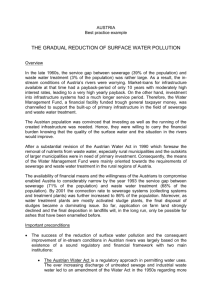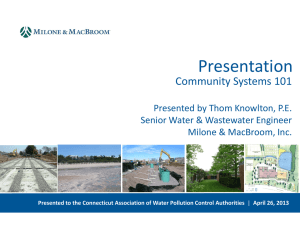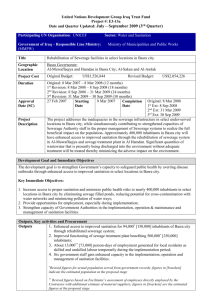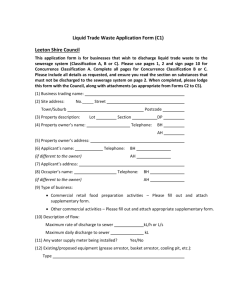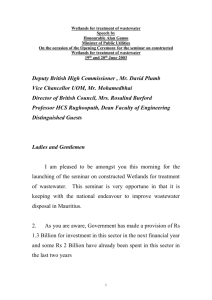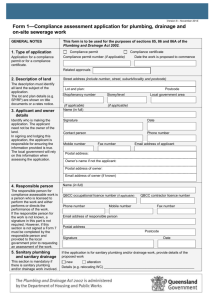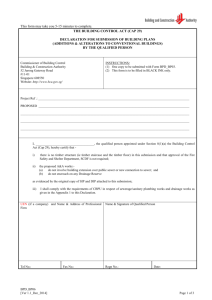Financial Viability, Sustainability and Social Cost
advertisement
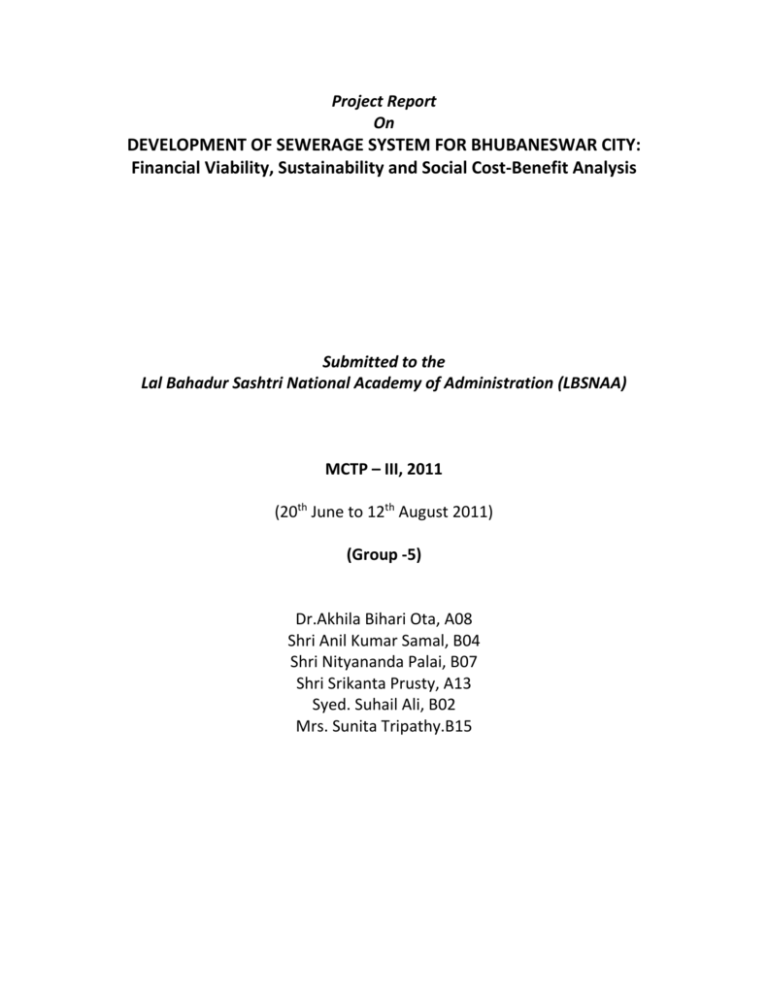
Project Report On DEVELOPMENT OF SEWERAGE SYSTEM FOR BHUBANESWAR CITY: Financial Viability, Sustainability and Social Cost-Benefit Analysis Submitted to the Lal Bahadur Sashtri National Academy of Administration (LBSNAA) MCTP – III, 2011 (20th June to 12th August 2011) (Group -5) Dr.Akhila Bihari Ota, A08 Shri Anil Kumar Samal, B04 Shri Nityananda Palai, B07 Shri Srikanta Prusty, A13 Syed. Suhail Ali, B02 Mrs. Sunita Tripathy.B15 TABLE OF CONTENTS 1.0 OVERVIEW OF THE PROJECT 1.1 Introduction 1.2 Current Status of the Sewerage System 1.3 Adverse effects of poor sewerage system and rationale for undertaking the present project 1.4 Salient features of the Project 1.5 Project Implementation Strategy 1.6 Institutional Mechanism for Implementation of the Project 1.7 Cost of the Project and Time Line 2.0 OPERATION AND MAINTENANCE PLANNING 3.0 ECONOMIC AND FINANCIAL ANALYSIS OF THE PROJECT 4.0 3.1 Assumptions and Parameters 3.2 Sustainability from O&M Cost Point of View 3.3 Cash Flow Statement from Developer’s Point of View 3.4 Financial Analysis from Economic Point of View ANALYSIS AND CONCLUSION. LIST OF TABLES 1. Real Investment Cost (Table -1) 2. Cash Flow Statement (Table -2) 3. FIRR Sensitivity Analysis (O&M) (Table – 3) 4. Economic IRR analysis (Table – 4) 5. Environmental IRR analysis (Table – 5) I. OVERVIEW OF THE PROJECT 1.1 INTRODUCTION: Government all over the world are increasingly realizing a need for providing and maintaining the urban environmental infrastructure facilities in order to keep the urban environment clean and healthy which essentially is the traditional function of the local Governments. However, the local Governments in India have not been able to fulfill the promise of adequate civic infrastructure to their rapidly increasing number of citizens mainly due to lack of institutional capabilities and financial resources. As a result most of the cities have grown into overcrowded and ill-equipped settlement with a high –polluted environment prone to frequent epidemics. The sewage from domestic and industrial sources in the cities has been polluting rivers and other bodies situated nearby. Sewage treatment is aimed at removing impurities present in wastewater in the form of floating material, suspended solids, biodegradable organics and elimination of pathogens so as to produce an effluent and sludge which can be disposed of in the environment without causing health hazards or nuisance. The Key Objectives of the project is to implement, monitor and maintain the sewerage system successfully with public awareness, public participation, and institutional arrangements. Since the project “Integrated Sewerage System of Bhubaneswar City” will involve massive mobilization of man power, materials, funds and will entail land acquisition etc. proper and effective project management is essential. Additional funds will be required for project management. Besides, the project work is time bound and the expected benefits has been designed to be delivered to the inhabitants of the city within the timeframe without giving any opportunity for cost overrun and time slippage. 1.2 THE CURRENT STATUS OF THE SEWERAGE SYSTEM: Bhubaneswar, the Capital City of Orissa State has grown rapidly in recent years with high inflow of population and industrial development. Rapid development has caused substantial increase in sewage and solid waste, but such increase cannot be treated due to lack of sewage treatment facilities and solid waste collection and disposal systems, thereby polluting drains and groundwater and deteriorating the sanitary conditions in the city. The major problems in sanitary conditions in Bhubaneswar are: 1.3. 1. Insufficient sewage network covering a limited area and absence of sewage treatment facilities 2. Absence of systematic solid waste collection and open dumping without leachate treatment or soil cover 3. Lack of financial resources and human capacity in institutions responsible for sewerage and solid waste management 4. and poor services in slum where the people live in sub human condition. ADVERSE EFFECTS OF POOR SEWERAGE SYSTEM AND RATIONALE FOR UNDERTAKING SUCH A PROJECT: Pollution of Water Bodies In absence of comprehensive sewerage system, untreated/partially treated sewage of the densely populated areas of Bhubaneswar city discharge into open unprotected natural drainage channels, which join to form Gangua Nallah, finally meets river Daya, the ultimate for the waste water discharges of Bhubaneswar city. Similarly, another major drain namely Drain No 1 (Patia) carrying the sewage of Chandrasekharpur & adjoining areas outfalls into Kuakhai river directly on the upstream of Drinking water Intake point. Deterioration of water quality of the rivers Kuakhai & Daya not only have adverse effect on the health & hygiene of end users but also endangers aquatic life. Open flow of sewage in unprotected storm water channels always carry the risk of pollution of ground water. There are around 7nos. of heritage ponds/lakes in the city, which are also polluted by untreated sewage. Environmental Problems At present only the main city area is sewered. Several areas in the city remain uncovered by sewerage system and these areas are severely affected due to stagnation of sewage, which pose severe threat to health in addition to causing nuisance of bad odour and over flow during monsoon Community Health Hygiene Absence of full fledged sanitation facility jeopardize health & hygiene of the people of the city in general. Sewage flowing in open drains promotes mosquito breeding, fly nuisance & pose health risk to citizens. Hindrance to economic growth & development of the city. The Existing water pollution levels, poor sanitation, lack of sewerage systems, polluted drains and rivers, overflowing sewage are highly deterrent to tourism activities, growth of industries especially the software development sector and trade and commerce. Growth of housing sector is also equally hindered due to absence of sewerage infrastructure in the city. In view of the above difficulties encountered by the people in respect of not having a dedicated sewerage system, there is great deal of necessity for such a project to ensure an environmentally appropriate Sewerage System. Taking in to account such problems, the Housing and Urban Development Department of the State Government of Orissa prepared a detailed project report in respect of Integrated Sewerage System for Bhubaneswar city with the technical assistance from IIT Roorkee, Bhubaneswar Municipal Corporation, Bhubaneswar Development Authority and State Public Health Engineering Organization. MoUD, GOI has approved the DPR for a total cost of Rs.75423 Lakhs. It further needs to be stated as can be revealed from the Table given below that out of the total cost of the project an amount of Rs.14000.00 Lakhs will be met from the 12th Finance Commission Grant, and the balance will be met by JNNURM funding. Table No. 1 (Abstract of the Estimate) Sl. No A 1 B 1 2 3 4 5 6 C Item of Work Cost in Lakhs Phase –I (Funded by the 12th Finance Commission Grant) Sewer laying in sewerage District I & II 14000.00 Sub Total Phase – II (Funding under JNNURM) Sewer laying in sewerage District – III, IV, V & VI Pumping Stations i.e. MPS, IPS & LS in Sewerage District – I, II, III, IV, V & VI Sewage Treatment Plant (STP) in Sewerage District - I, II, III, IV, V & VI Renovation and replacement of old sewers Low Cost sanitation 14000.00 Cost of preparation of DPR, training, capacity building, cost of the land, public awareness community participation, IEC, post project monitoring and A & OE Sub Total Grand Total (A+B) 11531.61 23340.54 5008.97 9235.11 11610.67 696.06 61422.35 75422.96 Say 75423.00 Remarks Approved by H & UD Department, Government of Odisha Approved by CSMC of MoUD, GOI. 1.4 SALIENT FEATURES OF THE PROJECT: It needs to be indicated here that the Sewerage System of Bhubaneswar City which is the Capital of Orissa and a sprawling city has been divided into six sewerage districts with independent pumping station and sewerage treatment plants. As indicated in the aforementioned paragraphs, the “Integrated Sewerage System for Bhubaneswar City” has been approved by MoUD, GOI for a total amount of Rs.75422.96 Lakhs for implementation. Salient features 1.5 Design Period Design Year Design Population Project Construction Period No. of Sewerage Districts No. of STPs New Sewers Sewage Treatment plant Total Project Cost : : : : : : : : : 30 years 2041 21.00 Lakhs 4 Years 06 06 250 KM 288 MLD (Capacity) 75423 Lakhs. PROJECT IMPLEMENTATION STRATEGY: The DPR prepared by IIT Roorkee was discussed several times with regard to technology and cost effectiveness before approval. The following are some of the major Components that have been envisaged in the plan for project implementation: I. Engagement of Project Management Consultant (PMC) II. Increase of Public Awareness III. Involvement and participation of public/community in project implementation IV. Setting up a Institutional framework in implementation and its sustainable continuance V. Capacity Building within the organization with responsibility to implement, operate and maintain the proposed works under Integrated Sewerage System of Bhubaneswar City VI. Environmental Monitoring during construction phase, Post Project Monitoring and EIA for effective output meeting the environmental standards. place for project 1.6 INSTITUTIONAL MECHANISM FOR IMPLEMENTATION OF THE PROJECT: A clearly defined and well spelt out institutional mechanism has been envisaged in the plan to be set up that would be legally, administratively and financially capable of performing functions necessary in respect of implementing the project. This has been done by defining the objectives of the institutional set up, methodology study, studying of existing implementation organizations and then proposing the new institutional arrangements. Partnership Issues: In Sewerage system, the BMC does not have a reach. Government of Orissa has already approved the reform memorandum by which all the PHEO staff in Bhubaneswar will be transferred to BMC for operations and Maintenance of Sewerage System. After reform the PHEO staff will be under the control of BMC who will be responsible for O&M of Sewerage System. As per policy of Government in the recent time, Public Private Participation (PPP) in the O & M of public utilities are encouraged. The sewage treatment plants can be maintained through private organizations with annual O&M contracts. Project Implementation Unit: To implement the Sewerage Project a Project Implementation Unit (PIU) under the Government in the Department of Urban Development has been proposed. It is to be headed by an IAS officer who would be assisted by a team comprising of technical and accounts personnel. This PIU will also serve as a nodal agency for projects under JNNUR, other programmes of the Government of India and externally funded projects. It will be responsible for project implementation including procurement of different components of project, evaluation and award of contracts, fund/cash flow planning and management, interacting with the project preparation and Design Cell and utilize their services in implementation of the project. One project Monitoring and Reform Cell shall function independently under Housing and Urban Development Department of Government of Orissa which will co-ordinate/liaison with various Government Departments, Ministry of Urban Development, Government of India and Consultants. Administrative expenses of the cell would be met from the fund earmarked for PIU. 1.7 COST OF THE PROJECT AND TIME LINE: The Project has been designed to span for a period of four years spanning from 2007 till 2011. The total cost of the project as estimated for completion in all respect has been calculated at Rs.75423 Lakhs. The details of the cost of the project with broad component wise break up is given at Table No.1. As mentioned in the table, 140 Crores shall be met from 12th Finance Commission Grant and the balance funds shall be met from JNNURM (80% GOI + 10% GoO + 10% BMC). Hence the total funding of the project comes in the form of Grant only and there is no loan component. The Project has been planned to be completed within 4 years with allocation of fund as follows: Year Amount (Rs. In Lakhs) 2007 10566 2008 18017 2009 21568 2010 20367 2011 4905 Total 75423 The sewerage system shall be augmented in the year 2021, 2022 and 2025 with additional investment of Rs.3276 Lakhs, Rs.3276 Lakhs and Rs.3298 Lakhs respectively. 2.0 OPERATION AND MAINTENANCE OF THE PROJECT At present, the Public Health Engineering Organization of the state Government is providing the sewerage service at Bhubaneswar city having 50000 domestic connections. The same agency will look after maintenance of the proposed project. The annual O&M Cost has been estimated for 2011 as per the details given in the following table on the basis of sewerage volume generated. Annual Estimate for O&M expenditure (Rs. In Lakhs) Sl. Items No Amount in Lakhs (For the year 2011) 1 Civil 108.41 2 E&M 145.01 3 Staff 307.66 4 Energy 776.48 5 D.G 102.55 6 Chemicals 24.92 Total 1465.06 Note: The O & M cost from 2011 to 2041 has been derived linearly considering an annual increase of 3.3%. The sewerage tariff structure for domestic category is given below. (a) Connection charges for new sewerage connection (b) Monthly charges for sewerage services : Rs. 1500.00 : Rs. 75/- The monthly sewerage tariff shall be collected with 5% hike every year. 3.0 ECONOMIC AND FINANCIAL ANALYSIS OF THE PROJECT 3.1 ASSUMPTIONS/PARAMETERS: 1. The Population projections in different year have been linearly interpolated between 2011 (project) and projected population for 2041. 2. It is presumed that each household to have five family members. 3. 70% of households are to be covered with sewerage connection and the balance 30% by low cost sanitations for urban slum. 4. Presently there are 35,000 of sewerage connections (2006). The number of connections by 2010is projected to 50,000 considering phase wise commissioning of the project. No. of new connections has been consider as 40% of balance households in each year. 5. As the number of industrial, commercial and institutional consumers are exactly not assessable, the tariff projections are made considering domestic connections only. 6. The prevailing connection charges for new sewage connection and tariff structure is given below: (a) Rs. 1500.00/ New Connection charge. (b) Rs. 75.00/Consumer/Month 7. The sewerage tariff will increase @5% per annum. 8. The operation and maintenance cost calculation has been derived for 2011 and year wise projection has been made linearly. 3.2 SUSTAINABILITY FROM O&M COST POINT OF VIEW: The details have been worked out in Table No. II which shows that the project can be made self sustained from 4th year that is 2014 of operation from O&M cost point of view. The deficit during 2011 to 2013 shall be met from the revenue generated by BMC. • It is a project of 30 Years starting from 2011(0 Year) to 2041 (30th Year) • The O&M Cost is to be borne from the Revenue Generated from two sources such as from fresh connection charges (1500/- per household) and monthly user charges (Rs.75/-) from each individual household connections with an annual increase in the rates at 5% per annum • In the first three years (that is from 2011 to 2013) the revenue was not adequate to cover the O&M Expenditure & for these 3 years the O&M expenses will be borne by BMC from their other sources of revenue, but from 2014 onwards the revenue has been adequate to cover the O&M expenses Thus, this project is sustainable from O&M Point of view. 3.3 CASH FLOW STATEMENT FROM DEVELOPER’S POINT OF VIEW: Table Number III indicates the Cash Flow from Developer’s point of view. It is seen that the N.P.V of net cash flow is negative, because it is a social project. As such the revenue generated is not sufficient to recoup the capital expenditures. 3.4 • Capital Expenditure has been made in two phases once from 2007 to 2011 (to the tune of Rs.75423 Lakhs) and in the Year 2021, 2022 & 2026 (to the tune of Rs.10850 Lakhs) • While the 2007-2011 Capital Expenditure are grants (not loans) from 12th F.C, GoO and GoI and has not been recouped from the revenue which is inadequate, the Capital Expenditure made in the year 2021, 22 & 26 has been met/adjusted from the revenue generation • The analysis shows that from 2014 onwards with the exception of 2021, 22 & 26, the revenue generated has been adequate to meet the O&M Expenditure, but it is inadequate to recoup the capital expenditure • Key Finding: Net Cash Flow as well as N.P.V of Net Cash Flow is negative. It is revealed that revenue generated by this project is not sufficient to recoup the capital expenditure. However, as this is a Social Project, this project is recommended to be continued /grounded. FINANCIAL ANALYSIS FROM ECONOMIC POINT OF VIEW: I. Quantified Economic Benefit: Only willingness to pay (Revenue Collection) and health benefits of this component are quantified. II. Income from user charges: The willingness to pay (Revenue Collection) for the sewerage services in Bhubaneswar is estimated on the basis of projected number of households to have sewerage connection x Rs.75/ per month (with an enhancement in the tariff of 5% every year) and fees @Rs.1500/ per new connection. III. Health Benefits: The health benefits have been estimated based on the economic loss related to the incidence of waterborne and water related diseases (e.g. typhoid, hepatitis, dysentery, gastroenteritis, cholera etc.). The total loss was divided into three elements: (a) Cost of productive time lost due to illness and early mortality, (b) Public medical expenditures and (c) Personal medical expenditures. a. Productive Time Lost: According to the latest Human Development Report published by Government of Orissa, the only study which estimated the total person years lost due to illness and shortened lifespan because of early mortality, was conducted in Orissa by Administrative Staff College of India. This study came to figure of 381 person years lost per 1,000 of the population. Out of these 381, only diarrhoea contributed approximately 9% of all causes. Therefore the share of the person years lost due all waterborne and water related diseases was estimate as 10%, which resulted in 38 person years per 1,000 of the population, i.e. 38722 person-years for the case of Bhubaneswar assuming the baseline population of the city to be 10,19,000 in the year 2011. With the average gross domestic income per capita in India being about Rs.60,950 the economic cost of productive time lost due to illness and early mortality caused by waterborne and water related diseases was estimated for Bhubaneswar at Rs.23,600 Lakh. b. Public Medical expenditure. The public medical expenditures is based on the Budget Estimate of BMC amounting to Rs. 203.5 lakhs for wages, salaries and medicine. In addition, Rs.2700 lakhs were estimated to be spent in Bhubaneswar from the State Budget for the year 2010-11 (calculated pro rata using the State Budget’s total expenditure on health and family welfare. Since there is no reliable statistics on this matter, assuming that only 14% of all public medical expenditure can be attributed to treatment of the waterborne and water related diseases, the total relevant public medical expenditure were estimates as Rs. 407 lakhs for the whole city in 2011. © Personal Medical expenditure The personal medical expenditure were estimated based on the survey conducted by the JBIC Team and expenditure to the whole city population. Since, the weighted average medical expenditure was Rs.924 per household per month, the total annual personal medical expenditure for the population of Bhubaneswar were estimated as Rs. 22600 lakhs a year, assuming that only 10% of this figure can be attributed to treatment of the waterborne and water related diseases, the total relevant personal medical expenditure were estimate as Rs. 2260 lakhs in 2011. d. Total health benefits. Finally, assuming that the sewerage project itself will allow reducing the incidence of the waterborne and water related deceases by 50% (and accordingly 50% were assumed to be caused by other reasons) the total baseline economic health benefits were estimated as Rs. 13,134 lakhs per year, calculated as [50% X (Rs 23600 + Rs 407 + Rs. 2260)]. e. Total economic benefits. After calculating the percapita health benefits in 2011, the same is interpolated up to 2041 as per projected population. The total economic benefits is calculated adding the revenue generation from sewerage tariff and the total health benefits accrued to the citizen, up to the design year 2041 basing on population statistics. f. Other Economic benefits. A number of economic benefits such as agricultural benefits, downstream drinking water supply benefits, other positive environmental impacts, increase of value of land and real estates in the city, roads improvement, enhanced opportunity for business development, growth of the tourism sector, to mention a few, could not be qualified. N.P.V of the net cash flow from Economic Point of View works out to Rs.65,445.78 and EIRR is derived at 17.57% which indicates that the project is economically feasible. 3.5 SENSITIVITY ANALYSIS: It is a Social Project with EIRR of 17.58% which is around 5% more than the prevailing cost of capital i.e. 12%. It is a prudent decision of Government to invest in this project with EIRR of 17.58% which is higher than the prevalent bank rate of interest in case of normal investment. It is further to note here that change of EIRR up to 5% due to deviation in realization of revenue and O&M cost shall not any way hamper the viability of the project. LIST OF TABLES 1. Real Investment Cost (Table -1) 2. Cash Flow Statement (Table -2) 3. Health Benefit analysis (Table – 3). 4. Economic IRR analysis (Table – 4) 5. Financial RR Sensitivity Analysis (Table – 5)
